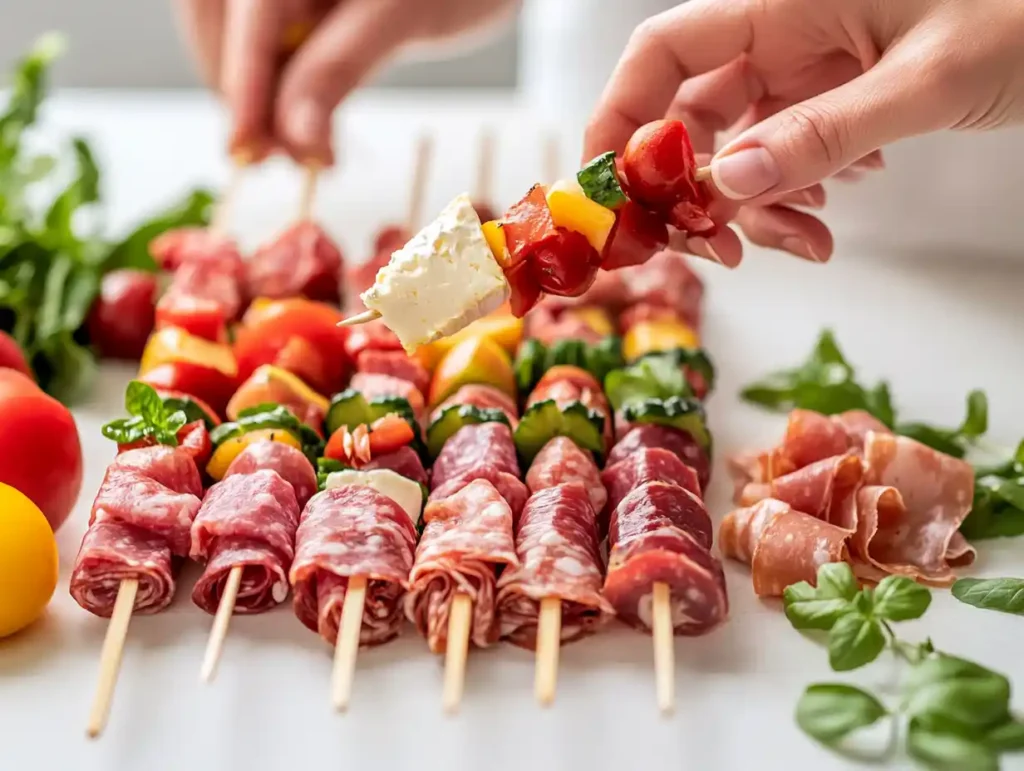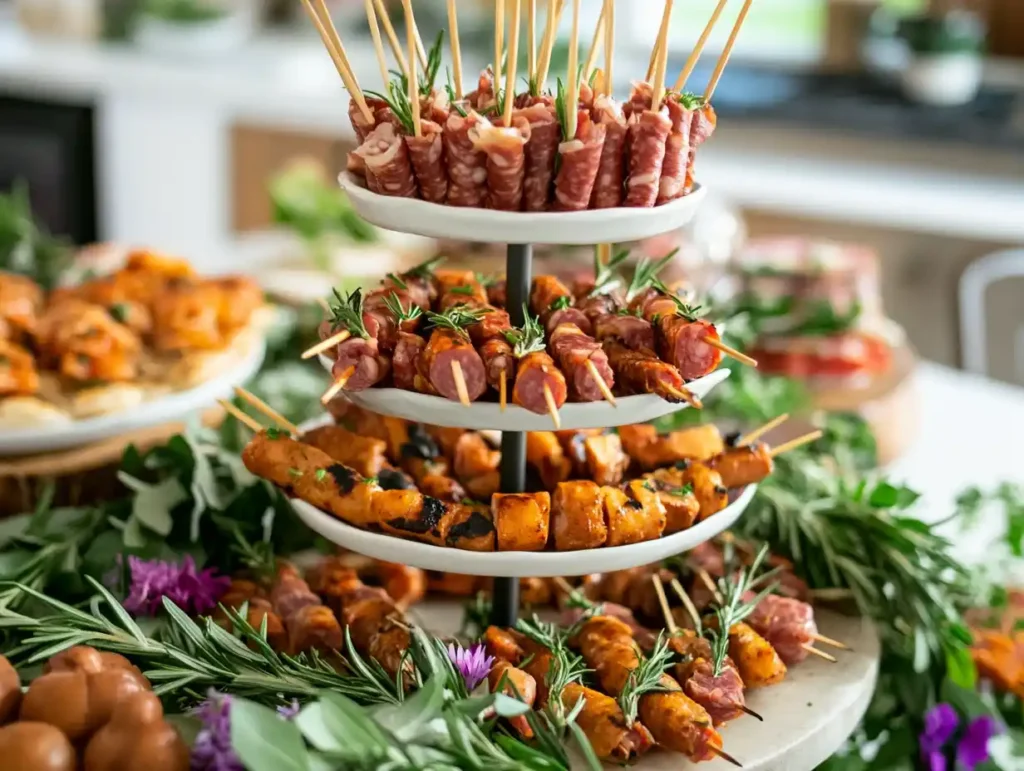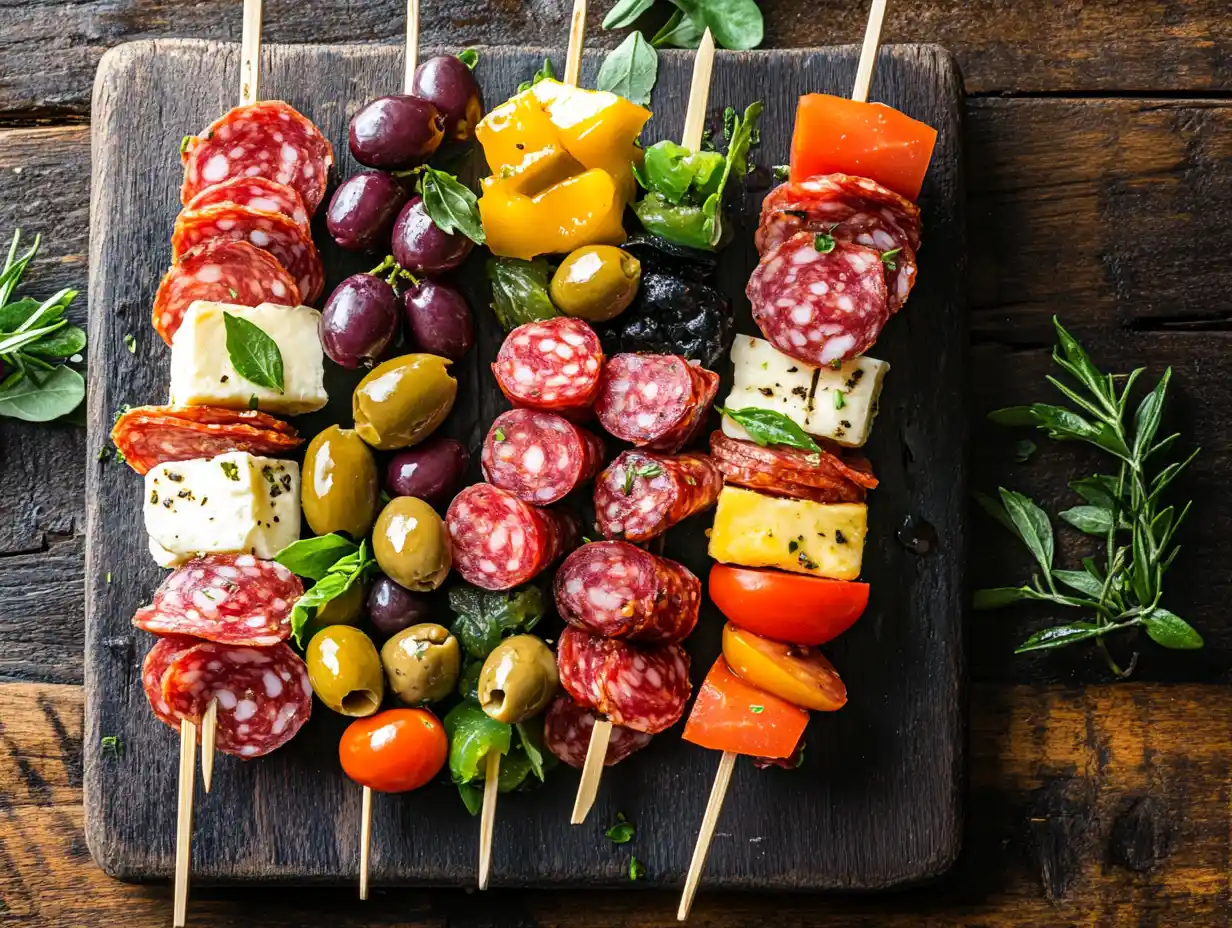Introduction
Charcuterie skewers transform the traditional charcuterie board into a convenient, handheld treat. They combine cured meats, cheeses, fruits, and more on a single stick, making them perfect for parties, picnics, and casual get-togethers. These trendy snacks stand out for their simplicity, versatility, and eye-catching appeal.
What makes charcuterie skewers so popular? First, they are easy to make, saving you time and effort. Second, they offer endless customization options, so you can cater to every taste and dietary need. Finally, they add a touch of elegance to any event, whether it’s a formal dinner or a casual backyard barbecue.
In this article, we’ll explore why charcuterie skewers are a must-try, how to assemble them step by step, and creative ways to use them for any occasion. Ready to dive in? Let’s get started!
What Are Charcuterie Skewers?
Charcuterie skewers are a modern twist on the traditional charcuterie board. Instead of arranging meats, cheeses, fruits, and crackers on a platter, you now assemble these delicious elements onto skewers. As a result, this creative presentation not only makes them easier to serve but also simplifies eating and sharing at events.
Originally, charcuterie began in France, where cured meats took center stage in beautifully arranged spreads. Over time, however, these boards evolved to include a variety of cheeses, fresh fruits, crunchy nuts, and other accompaniments. Today, charcuterie skewers provide a fresh and convenient way to enjoy these timeless flavors. In fact, their bite-sized portions make them perfect for any occasion, whether casual or formal.
Why Are They Popular?
One reason for their growing popularity is their convenience. Unlike traditional boards, skewers allow guests to grab a pre-portioned snack without needing utensils or plates. Their customizable nature also means you can tailor them to suit different themes, tastes, and dietary needs.
Another advantage is their aesthetic appeal. Skewers let you showcase colorful ingredients in an eye-catching way, making them a favorite for Instagram-worthy party spreads. From casual picnics to elegant weddings, charcuterie skewers fit seamlessly into any event.
Benefits of Charcuterie Skewers
Charcuterie skewers stand out for their versatility and convenience. Whether you’re hosting a formal dinner, throwing a casual party, or prepping snacks for a picnic, these skewers adapt to any occasion. Their compact size and portability make them a hit for both small gatherings and large events.
Perfect for Any Occasion
Charcuterie skewers shine at events because they’re easy to serve and eat. Guests don’t have to juggle plates or cutlery—they can simply pick up a skewer and enjoy. This makes them ideal for standing-room-only parties, cocktail hours, and outdoor settings like barbecues or picnics.
For more formal occasions, such as weddings or corporate events, charcuterie skewers add a touch of sophistication. Arrange them on elegant trays or display them upright in decorative jars for a clean, polished look.
Customization and Dietary Inclusivity
One of the best features of charcuterie skewers is how customizable they are. You can create skewers to fit any dietary preference or restriction. For vegetarian guests, swap meats for marinated vegetables or plant-based proteins. For gluten-free options, skip the crackers and focus on fresh produce and cheeses.
In addition, you can cater to flavor preferences by mixing and matching sweet and savory elements. Pair sharp cheeses with fresh fruit, or combine cured meats with a drizzle of honey for a delightful contrast.
Easy to Make and Transport
Unlike a large charcuterie board that requires assembly on-site, skewers can be prepared in advance and transported easily. Their compact size means you can store them in containers, ensuring they stay fresh until it’s time to serve.
Plus, the assembly process itself is straightforward. You don’t need advanced cooking skills or fancy tools—just some wooden skewers and fresh ingredients. This makes charcuterie skewers an accessible option for both experienced hosts and beginners.
Essential Ingredients for Charcuterie Skewers
Creating charcuterie skewers starts with choosing the right ingredients. The beauty of these snacks lies in their variety, so it’s essential to balance flavors and textures. Here are the core components to include:
Proteins – The Heart of the Skewer
Cured meats are a staple in charcuterie. Consider these popular options:
- Salami: Its robust flavor pairs well with cheeses and fruits.
- Prosciutto: This thinly sliced meat adds a salty, delicate touch.
- Pepperoni: A classic choice, especially for casual gatherings.
- Chorizo: Offers a slightly spicy kick for adventurous palates.
For vegetarian alternatives, try marinated tofu, roasted chickpeas, or grilled mushrooms.
Cheeses – A Perfect Pairing
Cheese is the perfect complement to meats and fruits. Use a mix of soft and hard varieties to add depth to your skewers. Some favorites include:
- Brie or Camembert: These creamy cheeses balance salty or tangy ingredients.
- Cheddar: A sharp, aged cheddar brings bold flavor.
- Gouda: Its mild, nutty taste makes it versatile for many combinations.
- Goat Cheese: Soft and tangy, it pairs beautifully with fruits like grapes or figs.
If you need dairy-free options, opt for plant-based cheeses made from cashews or almonds.
Fresh Fruits and Veggies
Fruits and vegetables add a refreshing element and a pop of color to your skewers. Try these options:
- Grapes: Sweet, bite-sized, and easy to skewer.
- Cherry Tomatoes: Perfect for adding a juicy, savory note.
- Melon Cubes: Pair wonderfully with prosciutto for a classic combination.
- Cucumber or Zucchini Slices: Offer crunch and a subtle flavor.
Crunchy and Savory Additions
For extra texture, include nuts, crackers, or pickled items like olives and cornichons. Almonds or walnuts are great choices, while mini breadsticks or pretzels can replace traditional crackers.
Sweet Touches
Add a little sweetness to balance savory flavors:
- Dried Fruits: Apricots, cranberries, or figs work beautifully.
- Honey Drizzle or Jams: These enhance the flavor of cheese and meats.
By combining these elements, you’ll create skewers that are visually appealing and bursting with flavor.
How to Assemble Charcuterie Skewers

Assembling charcuterie skewers is a simple yet rewarding process. With a bit of creativity and attention to detail, you can craft skewers that not only taste amazing but also look stunning. Follow these steps to make your own.
Step-by-Step Guide
- Prepare the Ingredients:
Begin by cutting meats, cheeses, and larger fruits or vegetables into bite-sized pieces. Ensure all items are small enough to fit comfortably on a skewer while being easy to eat. - Select the Skewers:
Use wooden or bamboo skewers for a rustic look, or go for metal skewers for a more elegant presentation. Choose shorter skewers (4-6 inches) for appetizers or longer ones (8-12 inches) for more substantial servings. - Layer the Ingredients:
Alternate between different textures, flavors, and colors as you thread items onto the skewer. For example, start with a grape, follow with a cube of cheddar, add a slice of salami, and finish with an olive. - Maintain Balance:
Avoid overloading the skewer. Aim for about 5-7 items per stick to keep them manageable and visually appealing. Balance sweet and savory elements for a well-rounded flavor profile. - Add a Finishing Touch:
Sprinkle fresh herbs like rosemary or thyme on the skewers for added aroma and visual appeal. You can also drizzle honey or balsamic glaze over the assembled skewers for extra flavor.
Tips for Perfect Skewers
- Plan a Colorful Presentation: Use a mix of vibrant ingredients like red tomatoes, green cucumbers, and orange cantaloupe to make your skewers pop.
- Focus on Stability: Thread items securely onto the skewer to prevent them from sliding off. Dense items like cheeses can act as anchors for lighter ingredients.
- Test the Flavors: Sample combinations as you go to ensure the flavors complement each other.
Recommended Tools and Accessories
- Cutting Boards and Knives: For precise cutting and preparation.
- Skewer Stand or Tray: Keeps the skewers upright or neatly arranged for presentation.
- Food Storage Containers: Useful for prepping skewers ahead of time and keeping them fresh.
With these steps and tips, you’ll have delicious and Instagram-worthy charcuterie skewers ready to impress your guests.
Creative Themes and Ideas for Charcuterie Skewers
Charcuterie skewers are incredibly versatile, and you can easily adapt them to match any theme or occasion. By experimenting with ingredients and presentation, you can make your skewers even more memorable. Here are some creative ideas to inspire you.
Seasonal Themes
Celebrate the flavors of each season by using fresh, in-season ingredients:
- Spring: Include fresh strawberries, asparagus tips, and goat cheese for a light and vibrant skewer.
- Summer: Combine watermelon cubes, feta, and mint for a refreshing snack. Add grilled shrimp for a touch of luxury.
- Fall: Use roasted butternut squash, aged cheddar, and dried cranberries for a cozy, autumn-inspired skewer.
- Winter: Create a festive skewer with prosciutto, brie, pomegranate seeds, and rosemary sprigs.
By focusing on seasonal produce, you’ll ensure your skewers taste fresh and fit the occasion perfectly.
Regional Inspirations
Take your guests on a culinary journey by showcasing flavors from around the world:
- Mediterranean: Use marinated olives, feta cheese, sundried tomatoes, and artichoke hearts.
- French: Pair brie, cornichons, and thinly sliced baguette cubes with slices of cured ham.
- Mexican: Include spiced chorizo, queso fresco, cherry tomatoes, and avocado cubes.
- Asian: Combine teriyaki chicken, pineapple chunks, and sesame-crusted tofu for a unique twist.
Using regional ingredients adds a layer of creativity and cultural appreciation to your skewers.
Kid-Friendly Versions
Charcuterie skewers aren’t just for adults—they’re great for kids, too! Create playful, colorful options that appeal to little ones:
- Use cubes of mild cheddar, turkey slices, and seedless grapes.
- Add mini pretzels or cheese crackers for a fun crunch.
- Include a sweet element like marshmallows or strawberries to keep them excited.
When designing kid-friendly skewers, keep the ingredients simple and safe to eat.
Holiday and Party Themes
For special occasions, match your skewers to the event’s colors or theme. For example:
- Christmas: Alternate green grapes, red salami, and white cheese cubes for a festive look.
- Halloween: Add orange cheddar, black olives, and roasted pumpkin seeds for a spooky snack.
- Birthdays: Use vibrant fruits like kiwi, pineapple, and watermelon to create cheerful, colorful skewers.
By tailoring your skewers to the occasion, you’ll impress your guests and create a memorable experience.
Pairing Suggestions for Charcuterie Skewers

Charcuterie skewers are delicious on their own, but the right pairings can elevate them even further. Whether you’re serving drinks, dips, or sauces, these additions will enhance the flavors of your skewers and complete your spread.
Beverage Pairings
The key to pairing beverages with charcuterie skewers is balancing the flavors of the ingredients. Here are some tried-and-true combinations:
Dips and Sauces
Adding dips or sauces gives your guests even more flavor options. Place small bowls near your skewers for easy access. Popular choices include:
- Honey: Drizzle over skewers with cheeses and fruits for a touch of sweetness.
- Balsamic Glaze: Perfect for Mediterranean-inspired combinations.
- Hummus: A creamy and flavorful addition for vegetarian skewers.
- Mustard or Aioli: Pair with skewers featuring smoked meats for a tangy kick.
Side Dishes
If you’re planning a larger spread, pair charcuterie skewers with complementary side dishes. Here are a few ideas:
- Crusty Bread or Breadsticks: Perfect for scooping up any leftover dips or sauces.
- Mixed Nuts: Add an extra layer of crunch and variety to your table.
- Fresh Salads: A light green or fruit salad balances the richness of the skewers.
With these pairing options, you can create a complete, well-rounded dining experience that suits any gathering.
FAQs About Charcuterie Skewers
To help you master charcuterie skewers, here are answers to some frequently asked questions.
What is the best size for skewers?
The size depends on the occasion. For instance, shorter skewers (4-6 inches) are great for bite-sized snacks, while medium skewers (8 inches) work well for more filling options. If you want to include more ingredients, opt for longer skewers (10-12 inches). Ultimately, match the size to your serving needs and presentation style.
How far in advance can I make charcuterie skewers?
You can make skewers up to 24 hours ahead if stored properly. To keep them fresh, first, use airtight containers, and second, refrigerate them immediately. Avoid adding items like crackers until just before serving to prevent sogginess. For extra freshness, wrap the container with plastic wrap.
What are some vegetarian or vegan options?
Vegetarian and vegan skewers are easy to make. For vegetarians, include marinated vegetables, fresh fruits, and plant-based cheeses. For vegans, use dairy-free cheeses, roasted chickpeas, or tofu. Clearly, these options ensure your skewers cater to everyone.
How do I keep the skewers intact?
First, anchor the skewer with sturdy ingredients like cheese or bread cubes. Then, thread lighter items like meats or leafy greens between them. Finally, avoid overloading and balance heavier items near the center.
What are some budget-friendly ingredients?
Affordable ingredients like cheddar, mozzarella, deli meats, and seasonal fruits work well. Add crackers, pickles, or nuts to stretch your budget while keeping the skewers delicious and appealing.
What are creative ways to serve them?
Present skewers on tiered trays, upright in decorative jars, or laid flat on platters. Alternatively, set up a skewer bar so guests can assemble their own. These ideas make serving both fun and elegant.
Conclusion
In conclusion, charcuterie skewers are a delightful mix of convenience, flavor, and creativity. They’re perfect for any gathering because they’re easy to customize and serve. Moreover, they cater to all dietary preferences, ensuring every guest feels included.
By combining fresh ingredients and thoughtful presentation, you can create skewers that are not only delicious but also visually stunning. Whether you’re hosting a casual picnic or a formal dinner, charcuterie skewers will elevate your event with minimal effort. So, why wait? Get creative, start assembling, and enjoy the compliments from your guests!
Craving more food ideas? Start with the basics of What is French Apple Pie Made Of? and What is French Apple Tart Made Of?. Plus, find out if Pastina Contains Eggs for your next pasta dish!

